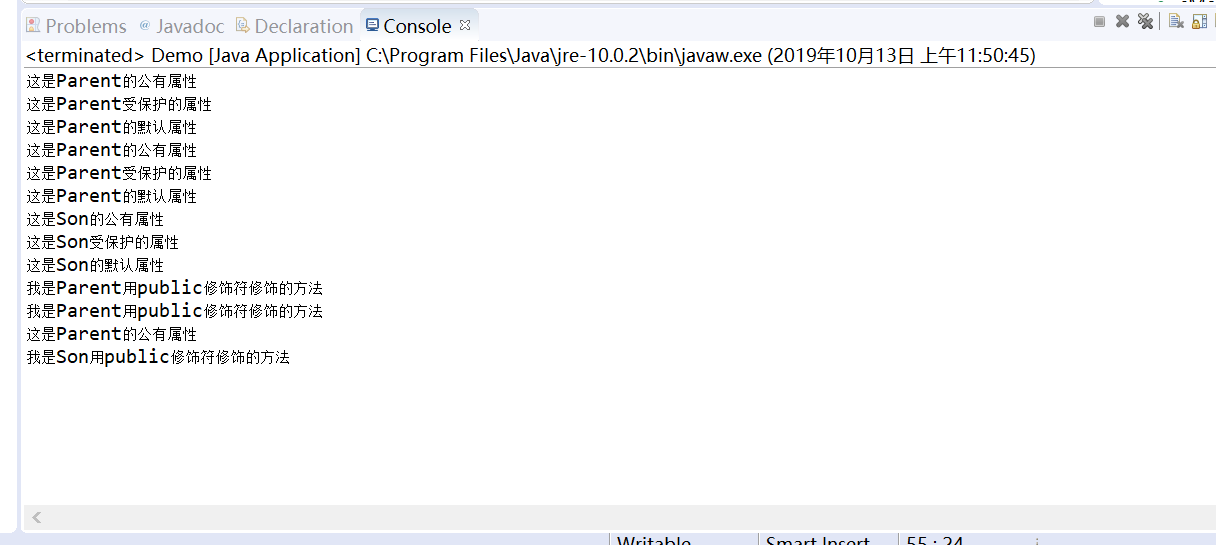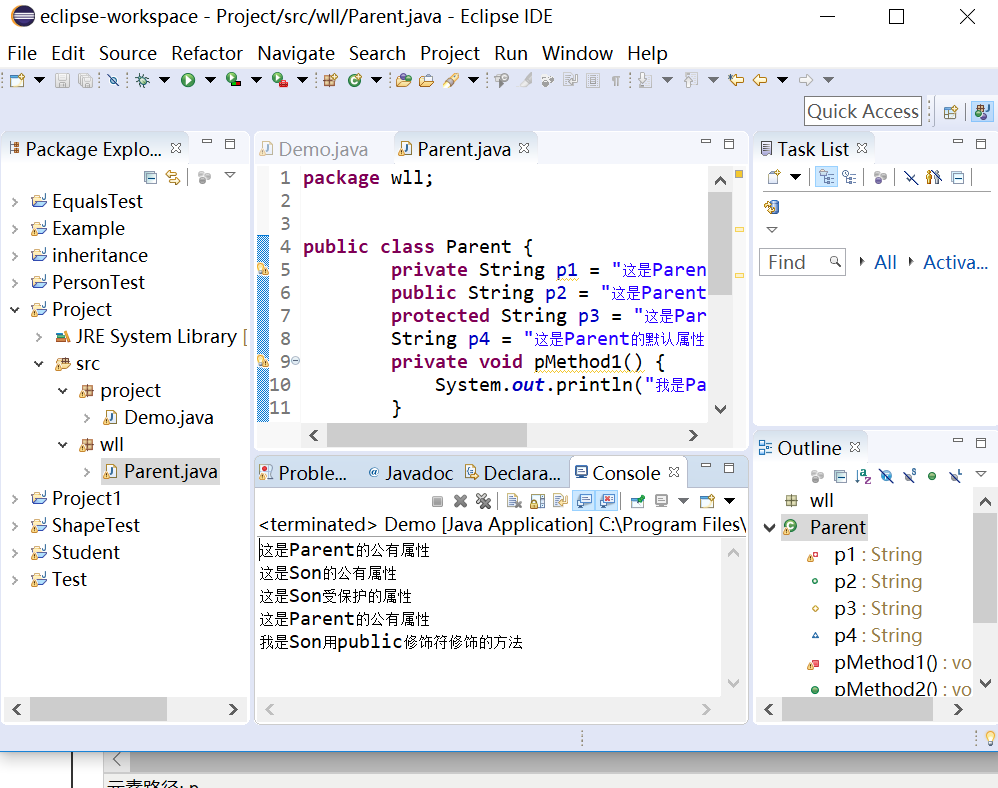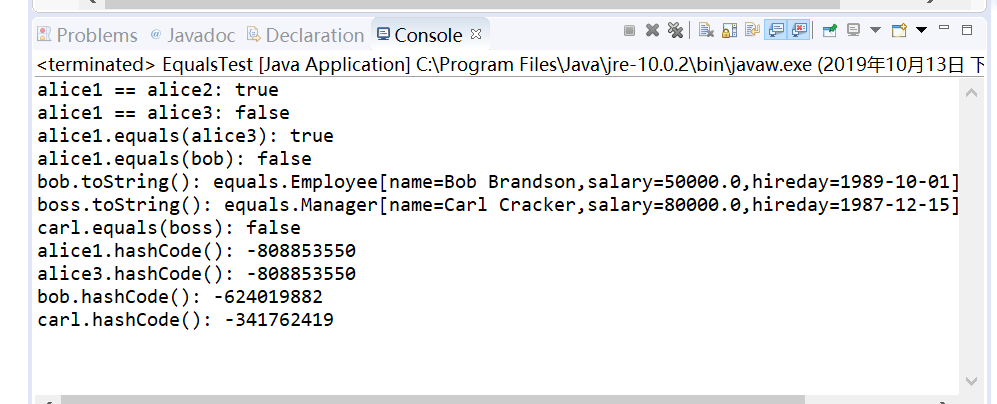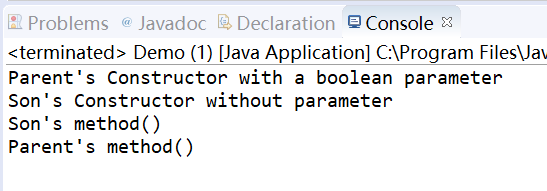吴丽丽-201871010123《面向对象程序设计(Java)》第七周学习总结
吴丽丽-201871010123《面向对象程序设计(Java)》第七周学习总结
| 项目 | 内容 |
| 这个作业属于哪个课程 |
http://www.cnblogs.com/nwnu-daizh/ |
| 这个作业的要求在哪里 | https://www.cnblogs.com/nwnu-daizh/p/11654436.html |
| 作业的学习目标 |
(1) 掌握四种访问权限修饰符的使用特点; (2) 掌握Object类的用途及常用API; (3) 掌握ArrayList类的定义方法及用法; (4)掌握枚举类定义方法及用途; (5)结合本章实验内容,理解继承与多态性两个面向对象程序设计特征,并体会其优点。 |
实验内容和步骤
实验1:在“System.out.println(...);”语句处按注释要求设计代码替换...,观察代码录入中IDE提示,以验证四种权限修饰符的用法。
package project; class Parent { private String p1 = "这是Parent的私有属性"; public String p2 = "这是Parent的公有属性"; protected String p3 = "这是Parent受保护的属性"; String p4 = "这是Parent的默认属性"; private void pMethod1() { System.out.println("我是Parent用private修饰符修饰的方法"); } public void pMethod2() { System.out.println("我是Parent用public修饰符修饰的方法"); } protected void pMethod3() { System.out.println("我是Parent用protected修饰符修饰的方法"); } void pMethod4() { System.out.println("我是Parent无修饰符修饰的方法"); } } class Son extends Parent{ private String s1 = "这是Son的私有属性"; public String s2 = "这是Son的公有属性"; protected String s3 = "这是Son受保护的属性"; String s4 = "这是Son的默认属性"; public void sMethod1() { System.out.println(p2);//分别尝试显示Parent类的p1、p2、p3、p4值 System.out.println("我是Son用public修饰符修饰的方法"); } private void sMethod2() { System.out.println("我是Son用private修饰符修饰的方法"); } protected void sMethod() { System.out.println("我是Son用protected修饰符修饰的方法"); } void sMethod4() { System.out.println("我是Son无修饰符修饰的方法"); } } public class Demo { public static void main(String[] args) { Parent parent=new Parent(); Son son=new Son(); System.out.println(parent.p2); System.out.println(parent.p3); System.out.println(parent.p4);//分别尝试用parent调用Paren类的方法、用son调用Son类的方法
System.out.println(son.p2);
System.out.println(son.p3);
System.out.println(son.p4);
System.out.println(son.s2);
System.out.println(son.s3);
System.out.println(son.s4);
parent.pMethod2();
son.pMethod2();
son.sMethod1(); } }
该代码是将子类父类以及主函数放在同一个包的同一个文件中,其除了parent类的private不可调用外,其他三个类都可以。子类除了不可以调用父类的私有域外,同样可以调用父类的其他域和方法。
程序结果运行如下:

以下是将parent类重新放入一个新的文件中:
parent类代码如下:
package project; public class Parent { private String p1 = "这是Parent的私有属性"; public String p2 = "这是Parent的公有属性"; protected String p3 = "这是Parent受保护的属性"; String p4 = "这是Parent的默认属性"; private void pMethod1() { System.out.println("我是Parent用private修饰符修饰的方法"); } public void pMethod2() { System.out.println("我是Parent用public修饰符修饰的方法"); } protected void pMethod3() { System.out.println("我是Parent用protected修饰符修饰的方法"); } void pMethod4() { System.out.println("我是Parent无修饰符修饰的方法"); } }
son类代码如下:
package project; class Son extends Parent{ private String s1 = "这是Son的私有属性"; public String s2 = "这是Son的公有属性"; protected String s3 = "这是Son受保护的属性"; String s4 = "这是Son的默认属性"; public void sMethod1() { System.out.println(p2);//分别尝试显示Parent类的p1、p2、p3、p4值 System.out.println("我是Son用public修饰符修饰的方法"); } private void sMethod2() { System.out.println("我是Son用private修饰符修饰的方法"); } protected void sMethod3() { System.out.println("我是Son用protected修饰符修饰的方法"); } void sMethod4() { System.out.println("我是Son无修饰符修饰的方法"); } } public class Demo { public static void main(String[] args) { Parent parent=new Parent(); Son son=new Son(); System.out.println(parent.p2); System.out.println(parent.p3); System.out.println(parent.p4); System.out.println(son.s2); System.out.println(son.s3); parent.pMethod3(); son.sMethod1(); son.pMethod3(); } }
程序运行结果如下:

下面是将parent类放入以自己名字命名的包里面
以下是Demo.java文件里的相关代码:
package project; import wll.Parent; class Son extends Parent{ private String s1 = "这是Son的私有属性"; public String s2 = "这是Son的公有属性"; protected String s3 = "这是Son受保护的属性"; String s4 = "这是Son的默认属性"; public void sMethod1() { System.out.println(p2);//分别尝试显示Parent类的p1、p2、p3、p4值 System.out.println("我是Son用public修饰符修饰的方法"); } private void sMethod2() { System.out.println("我是Son用private修饰符修饰的方法"); } protected void sMethod3() { System.out.println("我是Son用protected修饰符修饰的方法"); } void sMethod4() { System.out.println("我是Son无修饰符修饰的方法"); } } public class Demo { public static void main(String[] args) { Parent parent=new Parent(); Son son=new Son(); System.out.println(parent.p2); System.out.println(son.s2); System.out.println(son.s3); son.sMethod1(); } }
以下是parent类的代码:
package wll; public class Parent { private String p1 = "这是Parent的私有属性"; public String p2 = "这是Parent的公有属性"; protected String p3 = "这是Parent受保护的属性"; String p4 = "这是Parent的默认属性"; private void pMethod1() { System.out.println("我是Parent用private修饰符修饰的方法"); } public void pMethod2() { System.out.println("我是Parent用public修饰符修饰的方法"); } protected void pMethod3() { System.out.println("我是Parent用protected修饰符修饰的方法"); } void pMethod4() { System.out.println("我是Parent无修饰符修饰的方法"); } }
以下是放入不同包里的运行结果:

这个实验主要是让我们了解关于四种访问权限的修饰符:
| 位置 | private | 默认 | protected | public |
| 同一个类 | 是 | 是 | 是 | 是 |
| 同一个包里的类 | 否 | 是 | 是 | 是 |
|
不同包内的子类 |
否 | 否 | 是 | 是 |
| 不同包并且不是子类 | 否 | 否 | 否 | 是 |
实验2:导入第5章以下示例程序,测试并进行代码注释。
测试程序1:
a)运行教材程序5-8、5-9、5-10,结合程序运行结果理解程序(教材174页-177页);
b) 删除程序中Employee类、Manager类中的equals()、hasCode()、toString()方法,背录删除方法,在代码录入中理解类中重写Object父类方法的技术要点。
Employee类代码如下:
package equals; import java.time.*; import java.util.Objects; public class Employee { private String name; //实例域定义 private double salary; private LocalDate hireDay; public Employee(String name, double salary, int year, int month, int day)//构造器定义 { this.name = name; this.salary = salary; hireDay = LocalDate.of(year, month, day); } public String getName() { return name; } public double getSalary() { return salary; } public LocalDate getHireDay() { return hireDay; } public void raiseSalary(double byPercent) { double raise = salary * byPercent / 100; salary += raise; } public boolean equals(Object otherObject) { // 快速检查对象是否相同 //这里获得一个对象参数,第一个if语句判断两个引用是否是同一个,如果是那么这两个对象肯定相等 if (this == otherObject) return true; // 如果显式参数为空,则必须返回false if (otherObject == null) return false; // getClass()方法是得到对象的类,如果两个对象的类不一样,那么就不相等 if (getClass() != otherObject.getClass()) return false; //现在我们知道另一个对象是非空雇员 //在以上判断完成,再将得到的参数对象强制转换为该对象,考虑到父类引用子类的对象的出现,然后再判断对象的属性是否相同 var other = (Employee) otherObject; //测试字段是否具有相同的值 return Objects.equals(name, other.name) && salary == other.salary && Objects.equals(hireDay, other.hireDay); } public int hashCode() // 哈希散列 { return Objects.hash(name, salary, hireDay); } // toString()方法,可自动生成 public String toString() { return getClass().getName() + "[name=" + name + ",salary=" + salary + ",hireDay=" + hireDay + "]"; } }
EqualsTest类代码如下:
package equals; /** * This program demonstrates the equals method. * @version 1.12 2012-01-26 * @author Cay Horstmann */ public class EqualsTest { public static void main(String[] args) { var alice1 = new Employee("Alice Adams", 75000, 1987, 12, 15); //创建对象,并初始化 var alice2 = alice1; var alice3 = new Employee("Alice Adams", 75000, 1987, 12, 15); var bob = new Employee("Bob Brandson", 50000, 1989, 10, 1); System.out.println("alice1 == alice2: " + (alice1 == alice2)); System.out.println("alice1 == alice3: " + (alice1 == alice3)); System.out.println("alice1.equals(alice3): " + alice1.equals(alice3)); System.out.println("alice1.equals(bob): " + alice1.equals(bob)); System.out.println("bob.toString(): " + bob); var carl = new Manager("Carl Cracker", 80000, 1987, 12, 15); var boss = new Manager("Carl Cracker", 80000, 1987, 12, 15); boss.setBonus(5000); System.out.println("boss.toString(): " + boss); System.out.println("carl.equals(boss): " + carl.equals(boss)); System.out.println("alice1.hashCode(): " + alice1.hashCode()); System.out.println("alice3.hashCode(): " + alice3.hashCode()); System.out.println("bob.hashCode(): " + bob.hashCode()); System.out.println("carl.hashCode(): " + carl.hashCode()); } }
Manager类代码如下:
package equals; public class Manager extends Employee { private double bonus; public Manager(String name, double salary, int year, int month, int day) { super(name, salary, year, month, day); bonus = 0; } public double getSalary() { double baseSalary = super.getSalary(); return baseSalary + bonus; } public void setBonus(double bonus) { this.bonus = bonus; } public boolean equals(Object otherObject) { if (!super.equals(otherObject)) return false; var other = (Manager) otherObject; //检查这个和其他属于同一个类 return bonus == other.bonus; } public int hashCode() { return java.util.Objects.hash(super.hashCode(), bonus); } public String toString() { return super.toString() + "[bonus=" + bonus + "]"; } }
其运行结果如下:

删除程序中Employee类、Manager类中的equals()、hasCode()、toString()方法,背录删除方法后代码如下:
Override后Manager类代码如下:
package equals; public class Manager extends Employee { private double bonus; public Manager(String name, double salary, int year, int month, int day) { super(name, salary, year, month, day); // TODO Auto-generated constructor stub bonus = 0; } public void setBonus(double bonus) { this.bonus = bonus; } @Override public double getSalary() { // TODO Auto-generated method stub double baseSalary= super.getSalary(); return baseSalary+bonus; } @Override public boolean equals(Object otherObject) { // TODO Auto-generated method stub if(!super.equals(otherObject)) return false; Manager other=(Manager)otherObject; return bonus==other.bonus; } @Override public int hashCode() { // TODO Auto-generated method stub return super.hashCode()+17*new Double(bonus).hashCode(); } @Override public String toString() { // TODO Auto-generated method stub return super.toString()+"[bonus="+bonus+"]"; } }
Override后Employee代码如下:
package equals; import java.time.*; import java.util.Objects; public class Employee { private String name; //实例域定义 private double salary; private LocalDate hireDay; public Employee(String name, double salary, int year, int month, int day)//构造器定义 { this.name = name; this.salary = salary; hireDay = LocalDate.of(year, month, day); } public String getName() { return name; } public double getSalary() { return salary; } public LocalDate getHireDay() { return hireDay; } public void raiseSalary(double byPercent) { double raise=salary*byPercent/100; salary+=raise; } @Override public boolean equals(Object otherObject) { // TODO Auto-generated method stub if(this==otherObject) return true; if(this==null) return false; if(getClass() != otherObject.getClass()) return false; Employee other=(Employee)otherObject; return Objects.equals(name,other.name)&&salary == other.salary&&Objects.equals(hireDay,other.hireDay); } @Override public int hashCode() { // TODO Auto-generated method stub return Objects.hash(name,salary,hireDay); } @Override public String toString() { // TODO Auto-generated method stub return getClass().getName()+"[name="+name+",salary="+salary+",hireday="+hireDay+"]"; } }
其运行结果如下:

测试程序2:
a) 在elipse IDE中调试运行程序5-11(教材182页),结合程序运行结果理解程序;
b) 掌握ArrayList类的定义及用法;
c) 在程序中相关代码处添加新知识的注释;
e)设计适当的代码,测试ArrayList类的set()、get()、remove()、size()等方法的用法。
程序代码如下:
package arrayList; import java.util.*; /** * This program demonstrates the ArrayList class. * @version 1.11 2012-01-26 * @author Cay Horstmann */ public class ArrayListTest { public static void main(String[] args) { // fill the staff array list with three Employee objects ArrayList<Employee> staff = new ArrayList<Employee>(); //声明和构造一个保存Employee对象的数组列表 staff.add(new Employee("Carl Cracker", 75000, 1987, 12, 15));//使用add方法将元素添加到数组列表中 staff.add(new Employee("Harry Hacker", 50000, 1989, 10, 1)); staff.add(new Employee("Tony Tester", 40000, 1990, 3, 15)); // raise everyone's salary by 5% for (Employee e : staff) e.raiseSalary(5); // print out information about all Employee objects for (Employee e : staff) System.out.println("name=" + e.getName() + ",salary=" + e.getSalary() + ",hireDay=" + e.getHireDay()); } }
Employee类代码如下:
package arrayList; import java.time.*; public class Employee { private String name; private double salary; private LocalDate hireDay; public Employee(String name, double salary, int year, int month, int day) { this.name = name; this.salary = salary; hireDay = LocalDate.of(year, month, day); } public String getName() { return name; } public double getSalary() { return salary; } public LocalDate getHireDay() { return hireDay; } public void raiseSalary(double byPercent) { double raise = salary * byPercent / 100; salary += raise; } }
运行结果如下:

在程序中添加remove(),get(),size()方法后代码如下:
package arrayList; import java.util.*; /** * This program demonstrates the ArrayList class. * @version 1.11 2012-01-26 * @author Cay Horstmann */ public class ArrayListTest { public static void main(String[] args) { // fill the staff array list with three Employee objects ArrayList<Employee> staff = new ArrayList<Employee>(); //声明和构造一个保存Employee对象的数组列表 staff.add(new Employee("Carl Cracker", 75000, 1987, 12, 15));//使用add方法将元素添加到数组列表中 staff.add(new Employee("Harry Hacker", 50000, 1989, 10, 1)); staff.add(new Employee("Tony Tester", 40000, 1990, 3, 15)); staff.remove(1); //从数组列表中删除元素 int n = staff.size(); System.out.println(n); System.out.println(staff.get(0)!=staff.get(1)); // raise everyone's salary by 5% for (Employee e : staff) e.raiseSalary(5); // print out information about all Employee objects for (Employee e : staff) System.out.println("name=" + e.getName() + ",salary=" + e.getSalary() + ",hireDay=" + e.getHireDay()); } }

测试程序3:
a) 编辑、编译、调试运行程序5-12(教材189页),结合运行结果理解程序;
b)掌握枚举类的定义及用法;
c)在程序中相关代码处添加新知识的注释;
d)删除程序中Size枚举类,背录删除代码,在代码录入中掌握枚举类的定义要求。
程序代码如下:
package enums; import java.util.*; /** * This program demonstrates enumerated types. * @version 1.0 2004-05-24 * @author Cay Horstmann */ public class EnumTest { public static void main(String[] args) { var in = new Scanner(System.in); System.out.print("Enter a size: (SMALL, MEDIUM, LARGE, EXTRA_LARGE) "); String input = in.next().toUpperCase(); Size size = Enum.valueOf(Size.class, input); //静态方法valueOf System.out.println("size=" + size); System.out.println("abbreviation=" + size.getAbbreviation()); if (size == Size.EXTRA_LARGE) System.out.println("Good job--you paid attention to the _."); } } //在枚举类型中添加一些构造器、方法和域 enum Size { SMALL("S"), MEDIUM("M"), LARGE("L"), EXTRA_LARGE("XL"); //实例名 private Size(String abbreviation) { this.abbreviation = abbreviation; } public String getAbbreviation() { return abbreviation; } private String abbreviation; }
程序运行结果如下:

删除程序中Size枚举类override后代码如下:
package enums; import java.util.*; /** * This program demonstrates enumerated types. * @version 1.0 2004-05-24 * @author Cay Horstmann */ public class EnumTest { public static void main(String[] args) { var in = new Scanner(System.in); System.out.print("Enter a size: (SMALL, MEDIUM, LARGE, EXTRA_LARGE) "); String input = in.next().toUpperCase(); Size size = Enum.valueOf(Size.class, input); //静态方法valueOf System.out.println("size=" + size); System.out.println("abbreviation=" + size.getAbbreviation()); if (size == Size.EXTRA_LARGE) System.out.println("Good job--you paid attention to the _."); } } //在枚举类型中添加一些构造器、方法和域 enum Size { SMALL("S"), MEDIUM("M"), LARGE("L"), EXTRA_LARGE("XL"); //实例名 private Size(String abbreviation) { this.abbreviation = abbreviation; } @Override public String toString() { // TODO Auto-generated method stub return super.toString(); } public String getAbbreviation() { return abbreviation; } public void setAbbreviation(String abbreviation) { this.abbreviation = abbreviation; } private String abbreviation; }
测试程序4:录入以下代码,结合程序运行结果了解方法的可变参数用法
代码如下:
public class TestVarArgus { public static void dealArray(int... intArray){ for (int i : intArray) System.out.print(i +" "); System.out.println(); } public static void main(String args[]){ dealArray(); dealArray(); dealArray(1, 2, 3); } }
程序运行结果如下:

实验3:编程练习:参照输出样例补全程序,使程序输出结果与输出样例一致。
public class Demo { public static void main(String[] args) { Son son = new Son(); son.method(); } } class Parent { Parent() { System.out.println("Parent's Constructor without parameter"); } Parent(boolean b) { System.out.println("Parent's Constructor with a boolean parameter"); } public void method() { System.out.println("Parent's method()"); } } class Son extends Parent { //补全本类定义 }
要求输出样式如下:
Parent's Constructor with a boolean parameter Son's Constructor without parameter Son's method() Parent's method()
补全代码后如下:
public class Demo { public static void main(String[] args) { Son son = new Son(); son.method(); } } class Parent { Parent() { System.out.println("Parent's Constructor without parameter"); } Parent(boolean b) { System.out.println("Parent's Constructor with a boolean parameter"); } public void method() { System.out.println("Parent's method()"); } } class Son extends Parent { Son(){ super(false); System.out.println("Son's Constructor without parameter");
public void method(){ System.out.println("Son's method()");
super.method(); } }
程序运行结果如下:

第二部分:实验总结
在本次实验中我掌握了四种访问权限修饰符的用法及其特点,Object类的用途及常用的API,并且了解了有关ArrayList类的定义及用法,知道了枚举类定义的方法,但是对枚举类的方法和用途还不太清楚,还有点模糊,对ArrayList的方法还不够熟练,在本次实验3中补全定义,感觉自己做得不太好,对继承之间的关系有点混乱,之后自己会通过问老师或者助教来将相关知识点弄懂掌握,同时也会通过线上的学习将知识点再次巩固。



